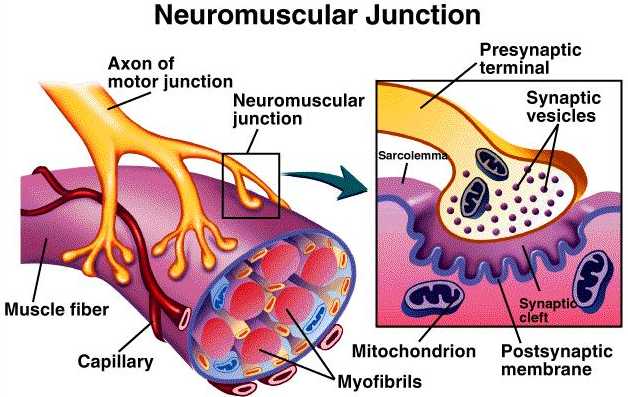
Types of Muscle Tissue: Skeletal,
Smooth, and Cardiac
* Skeletal, aka "striated", aka "voluntary" - attached to
bones and under conscious, willful control. Has the ability to contract (shorten)
and thereby bring about movement
I. Muscle and Muscle Fiber Structure: A muscle is composed of many muscle fibers (muscle fiber = muscle cell). The individual muscles are separated from each other and held in place by a covering called the FASCIA. This fascia also forms TENDONS and APONEUROSES connecting muscles to bones and muscles to muscles (tendons & ligaments)
A muscle also contains 3 different layers of connective tissue:
Epimysium - outermost layer, surrounds entire muscle
Perimysium - separated and surrounds the FASCICLES (bundles) of muscle fibers
Endomysium - surrounds each individual muscle fiber
Skeletal muscle fibers contain numerous nuclei and mitochondria --> Energy
The muscle fiber membrane is called the SARCOLEMMA and the cytoplasm is called the SARCOPLASM. Within the sarcoplasm are many parallel fibers known as MYOFIBRILS

Each myofibril is made of many protein
filaments called MYOFILAMENTS. There are two types:
MYOSIN - thick filaments
ACTIN - thin filaments
Structure of a SARCOMERE (functional unit of a muscle)
Actin and Myosin filaments are arranged in an overlapping pattern of light ("I" bands) and dark ("A" bands). In the middle of each "I" band is a line called a "Z" line. The section of a myofibril from one Z-line to the next Z-line is the SARCOMERE.
*** The arrangement of these sarcomeres next to each other produces the STRIATIONS
of the skeletal muscle fibers.
Each Myofibril is surrounded by a
network of channels called SARCOPLASMIC RETICULUM.
TRANVERSE TUBULES pass through the fibers - see p174


II. How Muscles Work with the Nervous System
NEUROMUSCULAR JUNCTION - where a NERVE FIBER and muscle fiber come together. A.K.A. Myoneural junction. MOTOR NEURON ENDINGS - nerve fiber caries the impulse that stimulates the muscle fibers
MOTOR END PLATE - specialized part of muscle fiber membrane (sarcolemma) located at the neuromuscular junction, has many folds
SYNAPTIC CLEFT - An actual "gap" or cleft which exits between the motor neuron endings and the motor end plate.
SYNAPTIC VESICLES - numerous vesicles in motor neuron endings, where neurotransmitters are stored before being released into the synaptic cleft.
NEUROTRANSMITTER - substance that
is released from nerve endings into synaptic cleft. Stimulates an impulse. In
this case, a "muscle impulse". One of the major neurotransmitters
is ACETYLCHOLINE. This brings about muscle contractions. CHOLINESTERASE is an
enzyme that breaks down acetylcholine

III. Events in Muscle Contraction:
Nerve impulse stimulates the release of a neurotransmitter (acetylcholine) from
synaptic vesicles into synaptic cleft ' stimulates muscle impulse ' impulse
spreads across sarcolemma and into fiber along the T-tubules ' this impulse
causes an increase in the cisternae's permeability to calcium ions. The S.R.
has a high conc. of Ca++. Calcium ions diffuse into the sarcoplasm ' the Ca++
causes the formation of "cross bridges"
between the actin and myosin filaments ' the filaments slide between each other
' this shortens the myofibrils which in turn shorten the muscle fibers, which
shortens the muscles
"Calcium Pump" returns
CA++ into the S.R. (requires energy- ATP)
Enzyme Cholinesterase stops action of Acetylcholine
IV. ENERGY SOURCE: Provided by ATP around myofibrils. ATP is produced by cellular
respiration which occurs in the mitochondria (requires O2 and glucose)
* Creatine Phosphate provides energy for the regeneration of ATP
* Only 25% of energy produced during
cellular respiration is used in metabolic processes - the rest is in the form
of HEAT. This is what produces our body heat and maintains body temperature.
More muscle activity = more heat

ATP = adenosine triphosphate | ADP = adenosine diphosphate
V: Other Terms
1. Threshold Stimulus
2. All-or-None Response
3. Motor Unit
5. Recruitment
6. Muscle Tone
7. Muscular Hypertrophy
8. Muscular Atrophy
9. Muscle Fatigue
10. Muscle Cramp
LABEL PRACTICE

WORD BANK
Fascicle
Endomysium (2)
Bone
Muscle Fiber
Epimysium
Perimysium
Tendon